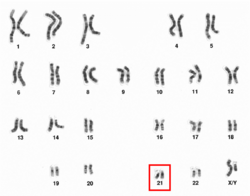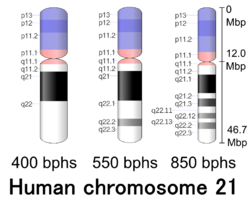Biology:Chromosome 21
| Chromosome 21 | |
|---|---|
 Human chromosome 21 pair after G-banding. One is from the mother, one is from the father. | |
 Chromosome 21 pair in human male karyogram. | |
| Features | |
| Length (bp) | 45,090,682 bp (CHM13) |
| No. of genes | 215 (CCDS)[1] |
| Type | Autosome |
| Centromere position | Acrocentric[2] (12.0 Mbp[3]) |
| Complete gene lists | |
| CCDS | Gene list |
| HGNC | Gene list |
| UniProt | Gene list |
| NCBI | Gene list |
| External map viewers | |
| Ensembl | Chromosome 21 |
| Entrez | Chromosome 21 |
| NCBI | Chromosome 21 |
| UCSC | Chromosome 21 |
| Full DNA sequences | |
| RefSeq | NC_000021 (FASTA) |
| GenBank | CM000683 (FASTA) |
Chromosome 21 is one of the 23 pairs of chromosomes in humans. Chromosome 21 is both the smallest human autosome and chromosome,[4] with 45 million base pairs (the building material of DNA) representing about 1.5 percent of the total DNA in cells. Most people have two copies of chromosome 21, while those with three copies of chromosome 21 have Down syndrome, also called "trisomy 21".
Researchers working on the Human Genome Project announced in May 2000 that they had determined the sequence of base pairs that make up this chromosome.[5] Chromosome 21 was the second human chromosome to be fully sequenced, after chromosome 22.
Genes
Number of genes
The following are some of the gene count estimates of human chromosome 21. Because researchers use different approaches to genome annotation, their predictions of the number of genes on each chromosome varies (for technical details, see gene prediction). Among various projects, the collaborative consensus coding sequence project (CCDS) takes an extremely conservative strategy. Thus CCDS's gene number prediction represents a lower bound on the total number of human protein-coding genes.[6]
| Estimated by | Protein-coding genes | Non-coding RNA genes | Pseudogenes | Source | Release date |
|---|---|---|---|---|---|
| CCDS | 212 | — | — | [1] | 2022-10-26 |
| HGNC | 215 | 185 | 194 | [7] | 2022-12-23 |
| Ensembl | 234 | 404 | 183 | [8] | 2017-03-29 |
| UniProt | 252 | — | — | [9] | 2018-02-28 |
| NCBI | 256 | 356 | 207 | [10][11][12] | 2017-05-19 |
Gene list
The following is a partial list of genes on human chromosome 21. For complete list, see the link in the infobox on the right.
Diseases and disorders
The following diseases and disorders are some of those related to genes on chromosome 21:
- Alzheimer's disease[13]
- Amyotrophic lateral sclerosis
- Atrial fibrillation, familial
- Autoimmune polyendocrine syndrome type 1
- Basal ganglia calcification
- Bethlem myopathy
- Closed angle glaucoma
- Cataract
- Down syndrome
- Erondu–Cymet syndrome
- Ewing sarcoma
- Glucocorticoid deficiency
- Hepatitis B (susceptibility to)
- Holocarboxylase synthetase deficiency
- Homocystinuria
- Hyperhomocysteinemia
- Hypotrichosis
- Immunodeficiency
- Inflammatory bowel disease
- Intellectual developmental disorder
- Jervell and Lange-Nielsen syndrome
- Keppen–Lubinsky syndrome
- Knobloch syndrome
- Leukocyte adhesion deficiency-1
- Majewski osteodysplastic primordial dwarfism type II (MOPD II, or MOPD2)
- Acute myeloid leukemia
- Non-small cell lung carcinoma[14]
- Nonsyndromic deafness
- Peripheral neuropathy
- Primary ciliary dyskinesia
- Primary immunodeficiency
- Primitive neuroectodermal tumor
- Prostate cancer
- Romano–Ward syndrome
- Ullrich congenital muscular dystrophy
- Unverricht–Lundborg disease, a form of progressive myoclonus epilepsy
Chromosomal conditions
The following conditions are caused by changes in the structure or number of copies of chromosome 21:
- Cancers: Rearrangements (translocations) of genetic material between chromosome 21 and other chromosomes have been associated with several types of cancer. For example, acute lymphoblastic leukemia (a type of blood cancer most often diagnosed in childhood) has been associated with a translocation between chromosomes 12 and 21. Another form of leukemia, acute myeloid leukemia, has been associated with a translocation between chromosomes 8 and 21.
- In a small percentage of cases, Down syndrome is caused by a rearrangement of chromosomal material between chromosome 21 and another chromosome. As a result, a person has the usual two copies of chromosome 21, plus extra material from chromosome 21 attached to another chromosome. These cases are called translocation Down syndrome. Researchers believe that extra copies of genes on chromosome 21 disrupt the course of normal development, causing the characteristic features of Down syndrome and the increased risk of medical problems associated with this disorder.
- Other changes in the number or structure of chromosome 21 can have a variety of effects, including intellectual disability, delayed development, and characteristic facial features. In some cases, the signs and symptoms are similar to those of Down syndrome. Changes to chromosome 21 include a missing segment of the chromosome in each cell (partial monosomy 21) and a circular structure called ring chromosome 21. A ring chromosome occurs when both ends of a broken chromosome are reunited.
- Duplication in Amyloid precursor protein (APP) locus (duplicated segment varies in length but includes APP) on Chromosome 21 was found to cause early onset familial Alzheimer's disease in a French family set (Rovelet-Lecrux et al.) and a Dutch family set.[13] Compared to Alzheimer's caused by missense mutations in APP, the frequency of the Alzheimer's caused by APP duplications is significant. All patients that have an extra copy of APP gene due to the locus duplication show Alzheimer's with severe cerebral amyloid angiopathy.
Cytogenetic band
| Chr. | Arm[19] | Band[20] | ISCN start[21] |
ISCN stop[21] |
Basepair start |
Basepair stop |
Stain[22] | Density |
|---|---|---|---|---|---|---|---|---|
| 21 | p | 13 | 0 | 311 | 1 | 3,100,000 | gvar | |
| 21 | p | 12 | 311 | 683 | 3,100,001 | 7,000,000 | stalk | |
| 21 | p | 11.2 | 683 | 1056 | 7,000,001 | 10,900,000 | gvar | |
| 21 | p | 11.1 | 1056 | 1274 | 10,900,001 | 12,000,000 | acen | |
| 21 | q | 11.1 | 1274 | 1367 | 12,000,001 | 13,000,000 | acen | |
| 21 | q | 11.2 | 1367 | 1584 | 13,000,001 | 15,000,000 | gneg | |
| 21 | q | 21.1 | 1584 | 2019 | 15,000,001 | 22,600,000 | gpos | 100 |
| 21 | q | 21.2 | 2019 | 2144 | 22,600,001 | 25,500,000 | gneg | |
| 21 | q | 21.3 | 2144 | 2330 | 25,500,001 | 30,200,000 | gpos | 75 |
| 21 | q | 22.11 | 2330 | 2485 | 30,200,001 | 34,400,000 | gneg | |
| 21 | q | 22.12 | 2485 | 2610 | 34,400,001 | 36,400,000 | gpos | 50 |
| 21 | q | 22.13 | 2610 | 2703 | 36,400,001 | 38,300,000 | gneg | |
| 21 | q | 22.2 | 2703 | 2858 | 38,300,001 | 41,200,000 | gpos | 50 |
| 21 | q | 22.3 | 2858 | 3200 | 41,200,001 | 46,709,983 | gneg |
References
- ↑ 1.0 1.1 "Search results - 21[CHR] AND "Homo sapiens"[Organism] AND ("has ccds"[Properties] AND alive[prop]) - Gene". 2022-10-26. https://www.ncbi.nlm.nih.gov/gene?term=21%5BChr%5D%20AND%20%22Homo%20sapiens%22%5BOrganism%5D%20AND%20%28%22has%20ccds%22%5BProperties%5D%20AND%20alive%5Bprop%5D%29&cmd=DetailsSearch.
- ↑ Tom Strachan; Andrew Read (2 April 2010). Human Molecular Genetics. Garland Science. p. 45. ISBN 978-1-136-84407-2. https://books.google.com/books?id=dSwWBAAAQBAJ&pg=PA45.
- ↑ 3.0 3.1 3.2 Genome Decoration Page, NCBI. Ideogram data for Homo sapience (850 bphs, Assembly GRCh38.p3). Last update 2014-06-03. Retrieved 2017-04-26.
- ↑ "Chromosome 21". https://ghr.nlm.nih.gov/chromosome/21.
- ↑ Hattori, M.; Fujiyama, A.; Taylor, T. D.; Watanabe, H.; Yada, T.; Park, H.-S.; Toyoda, A.; Ishii, K. et al. (2000). "The DNA sequence of human chromosome 21". Nature 405 (6784): 311–319. doi:10.1038/35012518. PMID 10830953. Bibcode: 2000Natur.405..311H.
- ↑ Pertea M, Salzberg SL (2010). "Between a chicken and a grape: estimating the number of human genes.". Genome Biol 11 (5): 206. doi:10.1186/gb-2010-11-5-206. PMID 20441615.
- ↑ "Statistics & Downloads for chromosome 21". 2022-12-23. https://www.genenames.org/cgi-bin/statistics?c=21.
- ↑ "Chromosome 21: Chromosome summary - Homo sapiens". 2017-03-29. http://mar2017.archive.ensembl.org/Homo_sapiens/Location/Chromosome?r=21.
- ↑ "Human chromosome 21: entries, gene names and cross-references to MIM". 2018-02-28. https://www.uniprot.org/docs/humchr21.txt.
- ↑ "Search results - 21[CHR] AND "Homo sapiens"[Organism] AND ("genetype protein coding"[Properties] AND alive[prop]) - Gene". 2017-05-19. https://www.ncbi.nlm.nih.gov/gene?term=21%5BCHR%5D%20AND%20%22Homo%20sapiens%22%5BOrganism%5D%20AND%20%28%22genetype%20protein%20coding%22%5BProperties%5D%20AND%20alive%5Bprop%5D%29&cmd=DetailsSearch.
- ↑ "Search results - 21[CHR] AND "Homo sapiens"[Organism] AND ( ("genetype miscrna"[Properties] OR "genetype ncrna"[Properties] OR "genetype rrna"[Properties] OR "genetype trna"[Properties] OR "genetype scrna"[Properties] OR "genetype snrna"[Properties] OR "genetype snorna"[Properties]) NOT "genetype protein coding"[Properties] AND alive[prop]) - Gene". 2017-05-19. https://www.ncbi.nlm.nih.gov/gene?term=21%5BCHR%5D%20AND%20%22Homo%20sapiens%22%5BOrganism%5D%20AND%20%28%28%22genetype%20miscrna%22%5BProperties%5D%20OR%20%22genetype%20ncrna%22%5BProperties%5D%20OR%20%22genetype%20rrna%22%5BProperties%5D%20OR%20%22genetype%20trna%22%5BProperties%5D%20OR%20%22genetype%20scrna%22%5BProperties%5D%20OR%20%22genetype%20snrna%22%5BProperties%5D%20OR%20%22genetype%20snorna%22%5BProperties%5D%29%20NOT%20%22genetype%20protein%20coding%22%5BProperties%5D%20AND%20alive%5Bprop%5D%29&cmd=DetailsSearch.
- ↑ "Search results - 21[CHR] AND "Homo sapiens"[Organism] AND ("genetype pseudo"[Properties] AND alive[prop]) - Gene". 2017-05-19. https://www.ncbi.nlm.nih.gov/gene?term=21%5BCHR%5D%20AND%20%22Homo%20sapiens%22%5BOrganism%5D%20AND%20%28%22genetype%20pseudo%22%5BProperties%5D%20AND%20alive%5Bprop%5D%29&cmd=DetailsSearch.
- ↑ 13.0 13.1 13.2 "APP duplication is sufficient to cause early onset Alzheimer's dementia with cerebral amyloid angiopathy". Brain 129 (Pt 11): 2977–83. 2006. doi:10.1093/brain/awl203. PMID 16921174.
- ↑ Kohno, T.; Kawanishi, M.; Matsuda, S.; Ichikawa, H.; Takada, M.; Ohki, M.; Yamamoto, T.; Yokota, J. (March 1998). "Homozygous deletion and frequent allelic loss of the 21q11.1-q21.1 region including the ANA gene in human lung carcinoma". Genes, Chromosomes & Cancer 21 (3): 236–243. doi:10.1002/(sici)1098-2264(199803)21:3<236::aid-gcc8>3.0.co;2-0. ISSN 1045-2257. PMID 9523199. https://pubmed.ncbi.nlm.nih.gov/9523199/.
- ↑ Genome Decoration Page, NCBI. Ideogram data for Homo sapience (400 bphs, Assembly GRCh38.p3). Last update 2014-03-04. Retrieved 2017-04-26.
- ↑ Genome Decoration Page, NCBI. Ideogram data for Homo sapience (550 bphs, Assembly GRCh38.p3). Last update 2015-08-11. Retrieved 2017-04-26.
- ↑ International Standing Committee on Human Cytogenetic Nomenclature (2013). ISCN 2013: An International System for Human Cytogenetic Nomenclature (2013). Karger Medical and Scientific Publishers. ISBN 978-3-318-02253-7. https://books.google.com/books?id=lGCLrh0DIwEC.
- ↑ Sethakulvichai, W.; Manitpornsut, S.; Wiboonrat, M.; Lilakiatsakun, W.; Assawamakin, A.; Tongsima, S. (2012). "Estimation of band level resolutions of human chromosome images". 2012 Ninth International Conference on Computer Science and Software Engineering (JCSSE). pp. 276–282. doi:10.1109/JCSSE.2012.6261965. ISBN 978-1-4673-1921-8. https://www.researchgate.net/publication/261304470.
- ↑ "p": Short arm; "q": Long arm.
- ↑ For cytogenetic banding nomenclature, see article locus.
- ↑ 21.0 21.1 These values (ISCN start/stop) are based on the length of bands/ideograms from the ISCN book, An International System for Human Cytogenetic Nomenclature (2013). Arbitrary unit.
- ↑ gpos: Region which is positively stained by G banding, generally AT-rich and gene poor; gneg: Region which is negatively stained by G banding, generally CG-rich and gene rich; acen Centromere. var: Variable region; stalk: Stalk.
- "Chromosome 21 and down syndrome: from genomics to pathophysiology". Nat Rev Genet 5 (10): 725–38. 2004. doi:10.1038/nrg1448. PMID 15510164.
- "Chromosome 21: a small land of fascinating disorders with unknown pathophysiology". Int J Dev Biol 46 (1): 89–96. 2002. PMID 11902692.
- Antonarakis SE (2001). "Chromosome 21: from sequence to applications". Curr Opin Genet Dev 11 (3): 241–6. doi:10.1016/S0959-437X(00)00185-4. PMID 11377958.
- Gilbert F (1997). "Disease genes and chromosomes: disease maps of the human genome. Chromosome 21". Genet Test 1 (4): 301–6. doi:10.1089/gte.1997.1.301. PMID 10464663.
- "The DNA sequence of human chromosome 21". Nature 405 (6784): 311–9. 2000. doi:10.1038/35012518. PMID 10830953. Bibcode: 2000Natur.405..311H.
- "Mechanism, detection and clinical significance of the reciprocal translocation t(12;21)(p12;q22) in the children suffering from acute lymphoblastic leukaemia". Leuk Res 28 (1): 35–42. 2004. doi:10.1016/S0145-2126(03)00160-7. PMID 14630078.
- "APP locus duplication causes autosomal dominant early-onset Alzheimer disease with cerebral amyloid angiopathy". Nature Genetics 38 (1): 24–6. 2005. doi:10.1038/ng1718. PMID 16369530.
- Anita Rauch; Christian T. Thiel; Detlev Schindler; Ursula Wick; Yanick J. Crow; Arif B. Ekici; Anthonie J. van Essen; Timm O. Goecke et al. (2008). "Mutations in the Pericentrin (PCNT) Gene Cause Primordial Dwarfism". Science Online 319 (5864): 816–9. doi:10.1126/science.1151174. PMID 18174396. Bibcode: 2008Sci...319..816R.
External links
- National Institutes of Health. "Chromosome 21". Genetics Home Reference. http://ghr.nlm.nih.gov/chromosome=21.
- "Chromosome 21". http://web.ornl.gov/sci/techresources/Human_Genome/posters/chromosome/chromo21.shtml.
 |




